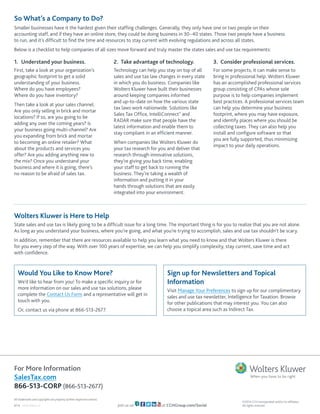Where Does a Sale Take Place in Cyberspace?
- 1. Where Does a Sale Take Place in Cyberspace? Staying on Top of the Changing Rules
- 2. Introduction State sales and use tax laws have long been an area of ongoing complexity and change, but emerging technologies have increased that complexity tenfold. It wasn’t that long ago when terms like “cloud computing” sounded more like science fiction. Today, they are well understood by most Americans. As more technology migrates to the cloud and as Software as a Service (SaaS) becomes a common means of software distribution, products are being digitized and downloaded instead of purchased on-site at the store. States are hungry for revenue, but don’t know quite how to proceed since their laws often define taxable goods as tangible items. States are taking very different approaches to taxing emerging technologies, making it increasingly difficult for companies to move forward with confidence. If you are feeling lost in the transition, you are not alone. The purpose of this white paper is to provide an overview of the state sales and use tax issues facing large and small companies today and to provide a road map for companies to see their way through the complexity. A Changing Landscape State sales and use laws have always had their unique quirks. Not long ago (it has since changed), North Carolina’s tax code defined “food” as any item that contained flour and exempted those items from tax. As a result, you could purchase a Snickers bar and not pay state sales tax because a Snickers® bar contained flour. If you wanted a Mars® bar, however, you’d better be prepared to pony up because Mars® bars did not contain flour. So you had two pieces of candy from the same supermarket shelf being treated very differently due to a technical definition. Similar issues are arising with emerging technology today. Take Microsoft® Office, for example. Just a few years ago, if you wanted to purchase a copy of Microsoft® Office, you would walk into a store like Best Buy® and pick up a DVD. That disc was taxable because the disc itself was tangible. Today, you can go to Microsoft.com and subscribe to Microsoft® Office 365. You receive the same Office functionality only the software is housed on Microsoft® servers, not on your computer. The method of delivery is what’s making one version taxable and one not taxable, depending on where you live. Today, we are probably more likely to download our music from iTunes® instead of purchasing CDs in a record store. Or we could access a music streaming service like Spotify® that allows subscribers to play music on any device for a subscription fee. The change in the delivery of products and services has meant changes to the ways states tax these items.
- 3. Increased Regulatory Complexity Predictably, states are taking very different approaches in how they treat digital or cloud-based products, making it exceedingly difficult for companies to stay on top of the multitude of regulations. For example, Pennsylvania, Texas and Utah have started to provide guidance on the taxability of SaaS products, while some states such as Colorado and Virginia have decided not to tax SaaS products, which could encourage cloud service providers to open offices and create jobs in their states. Some states have begun moving forward on a case-by-case basis, while others haven’t even begun grappling with this thorny issue. One thing is clear: as cloud computing continues to evolve, and as more states seek fresh revenue sources, we can anticipate a great deal more action and change in this space. The challenge is for companies to stay on top of the evolving regulations. Many states are starting to change their definitions of a taxable product. In the past, states would tax tangible items. If it could be held and touched, it could be taxed. Now we’re seeing states change the wording of tax laws, introducing a great deal of ambiguity by saying that personal property is anything that can be perceived by the senses of the purchaser. In addition, they are changing the definition of “situsing” rules. Put another way, they are beginning to redefine where a sale is sourced for tax purposes. For transactions involving sales of digital content and cloud services, the proper application of situsing rules is largely dependent upon how these product offerings are characterized in a given state. The threshold issue is to determine how the product or service is characterized for sales and use tax purposes (e.g., tangible personal property, service, etc.). Once that determination is made, each state’s situsing rules may be applied. However, states have proven inconsistent in characterizing the sale of emerging technologies as tangible personal property or services for sales and use tax purposes. These types of state inconsistencies are the rule, rather than the exception. Nevertheless, once the characterization of a product and its taxability is determined, an understanding of a state’s sourcing rules is essential. Who Gets the Tax? When a company with a cloud in one state sells to a customer in another, which state gets the tax? Is it the state where the user buys the product? Or the state where the server is located? The answer, as you might have guessed, is “it depends.” Some states are using the billing address of who purchased the product. Others have decided to source the tax to the location of the server. Still others take a multiple points of use approach. When companies have multiple locations, things tend to get complicated quickly. Questions that need to be answered include: ll Which jurisdiction gets the tax when software is downloaded from a server in one state and used by a customer in another? ll Where did the property change hands? ll Where did the property originate from? ll Who shifts the property to someone else? ll Where is the address that gets the bill? A Ray of Hope On the bright side, there’s a growing movement toward simplifying the state sales and use tax code to create a common, universal definition of how to tax these emerging technology products. The Streamlined Sales Tax Governing Board, which consists of 24 states coming together to create a uniform sales tax law, has attempted to lead the charge in establishing clear and predictable rules around situsing. Unfortunately, it appears that these issues will not be resolved in the near future. Based on the recent introduction of federal legislation intended to mandate collection on remote sellers (the Marketplace Fairness Act or MFA), the short-term efforts of the Streamlined Sales Tax Governing Board will be focused on the implementation issues associated with federal legislation, rather than on these more substantive issues. That leaves businesses in a challenging position, because they are the most at risk of being audited. Unfortunately, the burden is on companies to stay on top of the murky state tax laws themselves, but many organizations are simply not staffed appropriately to do that effectively.
- 4. All trademarks and copyrights are property of their respective owners. Join us on at CCHGroup.com/Social Wolters Kluwer is Here to Help State sales and use tax is likely going to be a difficult issue for a long time. The important thing is for you to realize that you are not alone. As long as you understand your business, where you’re going, and what you’re trying to accomplish, sales and use tax shouldn’t be scary. In addition, remember that there are resources available to help you learn what you need to know and that Wolters Kluwer is there for you every step of the way. With over 100 years of expertise, we can help you simplify complexity, stay current, save time and act with confidence. Would You Like to Know More? We’d like to hear from you! To make a specific inquiry or for more information on our sales and use tax solutions, please complete the Contact Us Form and a representative will get in touch with you. Or, contact us via phone at 866-513-2677. Sign up for Newsletters and Topical Information Visit Manage Your Preferences to sign up for our complimentary sales and use tax newsletter, Intelligence for Taxation. Browse for other publications that may interest you. You can also choose a topical area such as Indirect Tax. So What’s a Company to Do? Smaller businesses have it the hardest given their staffing challenges. Generally, they only have one or two people on their accounting staff, and if they have an online store, they could be doing business in 30–40 states. Those two people have a business to run, and it’s difficult to find the time and resources to stay current with evolving regulations and across all states. Below is a checklist to help companies of all sizes move forward and truly master the states sales and use tax requirements: 8/14 2014-0063-12 For More Information SalesTax.com 866-513-CORP (866-513-2677) 1. Understand your business. First, take a look at your organization’s geographic footprint to get a solid understanding of your business. Where do you have employees? Where do you have inventory? Then take a look at your sales channel. Are you only selling in brick and mortar locations? If so, are you going to be adding any over the coming years? Is your business going multi-channel? Are you expanding from brick and mortar to becoming an online retailer? What about the products and services you offer? Are you adding anything new to the mix? Once you understand your business and where it is going, there’s no reason to be afraid of sales tax. 2. Take advantage of technology. Technology can help you stay on top of all sales and use tax law changes in every state in which you do business. Companies like Wolters Kluwer have built their businesses around keeping companies informed and up-to-date on how the various state tax laws work nationwide. Solutions like Sales Tax Office, IntelliConnect® and RADAR make sure that people have the latest information and enable them to stay compliant in an efficient manner. When companies like Wolters Kluwer do your tax research for you and deliver that research through innovative solutions, they’re giving you back time, enabling your staff to get back to running the business. They’re taking a wealth of information and putting it in your hands through solutions that are easily integrated into your environment. 3. Consider professional services. For some projects, it can make sense to bring in professional help. Wolters Kluwer has an accomplished professional services group consisting of CPAs whose sole purpose is to help companies implement best practices. A professional services team can help you determine your business footprint, where you may have exposure, and identify places where you should be collecting taxes. They can also help you install and configure software so that you are fully supported, thus minimizing impact to your daily operations. ©2014 CCH Incorporated and/or its affiliates. All rights reserved.




